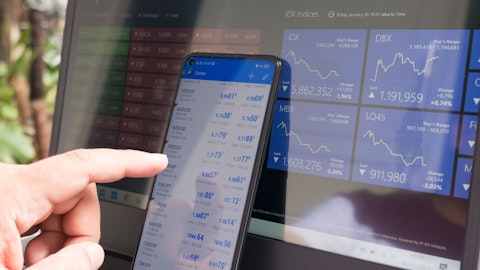In this article, we will talk about the 35 most expensive countries in the world to live in. We will discuss the changing dynamics of the dollar and how it has impacted different industries. You can skip our detailed analysis and head straight to the 10 Most Expensive Countries in the World To Live In.
Ever since the COVID-19 pandemic took to rest, the world has resorted to talking more and more about the economic implications the pandemic has left the world to deal with. The uncertainty that comes with the current economic status causes alarm to economists.
As per a report by the World Economic Forum, Asia is among the fastest-growing regions in the world post-pandemic. China is expected to lead economic growth in the region, with 97% of economists predicting moderate growth. Compared to Asia, the economic outlook for Europe is particularly on the rough side. However, more evidence is required to suggest whether the region will face weak economic growth. Only 6% of respondents expected weak growth in Europe, a significant improvement from 68% of economists suggesting weak growth in January 2023. However, global economics is more complex and the strengthening of the US dollar has had a greater impact than expected.
What is Happening With the Dollar?
Since last year, the dollar has gained immense traction in the world. As a global currency reserve, the dollar has been in high demand by countries and the general population. However, the volatility and uncertainty surrounding global economics is a cause of alarm to economists.
The strengthening dollar ultimately has widespread implications for other economies, especially emerging markets. The US dollar particularly makes these economies cheaper for citizens. For instance, a strong dollar will indefinitely make it cheaper for people to buy goods abroad. The currency dynamics immensely benefit people traveling to other parts of the world from the United States. As of last year, there have been various reports of Europe being considerably cheaper for US citizens.
For instance, if we look back to 2022, a report by Bloomberg published on May 22, 2022, suggested that with the dollar rising, it is the best time for Americans to take trips to other parts of the world, especially Europe. The dollar rose to new heights last year. As a foreign currency reserve, the dollar is a safe option.
Additionally, the Russia-Ukraine conflict was a major blow to the Euro. Russia is a major trading partner in the region. Therefore, any conflict in the country would have significant repercussions on the value of the Euro. To cater to the declining value of the Euro in 2022, Europeans turned to purchasing the dollar as a haven.
Lastly, rampant rate hikes by the Fed added to the strength of the dollar. The economic policies of the United States have boosted the value of the dollar globally. Moreover, as of last year and early 2023, economists predicted that the Fed will continue to increase interest rates and contribute to a greater global demand for the dollar.
However, 2023 has only brought significant changes to the global economy. On August 30, Reuters reported that the dollar’s strength against the Euro was short-lived. On Wednesday, the dollar dropped to a two-week low against the Euro. Such has made traveling to Europe more expensive, crushing the hopes of people who had already booked a summer Euro trip hoping for a cheap vacation. With this recent update, experts have begun to wonder whether the Fed will further increase interest rates, as opposed to the current pattern. According to experts, there is a 91% chance that the drop in the dollar marks the conclusion of the tightening cycle by the Fed.
As global economic conditions continue to change, it has become increasingly difficult to predict economic outcomes. Therefore, we can not assess whether the US dollar will continue to rise or face a major decline in value towards the end of 2023.
How Do Companies Win Against the US Dollar?
The uncertainty concerning the dollar has hardly hit US companies catering significantly to the overseas market. Multinational corporations, with most of their market located outside the United States, tend to suffer the most when the dollar is volatile.
However, the outlook for multinational corporations is not all bleak. Companies like The Coca-Cola Company (NYSE:KO) have been standing strong against rising prices and declining global demand. On July 26, Reuters reported that the company forecasts an increase in organic revenue growth of 8-9% for the fiscal year 2023, despite an increase in the average beverage price by 10% and declining demand in North America by 1%.
The Coca-Cola Company’s (NYSE:KO) success tells another story. Companies like The Coca-Cola Company (NYSE:KO) heavily invest in ancillary projects, ensuring they stay in demand for longer. On May 25, the company reported a partnership with global donors and the African government to improve the healthcare system in Africa systematically. Project Last Mile is focused on providing and distributing life-saving medicines to everyone in Africa. Engaging in such projects eventually gains traction for a company, reducing the price elasticity of demand, as is the case for The Coca-Cola Company (NYSE:KO).
Additionally, Procter & Gamble Company (NYSE:PG) announced fourth-quarter results for the fiscal year 2023 on July 28. The company reported earnings per share of $1.37 and outperformed estimates by $0.05. The company’s revenue for the quarter amounted to $20.55 billion, up 5.32% year over year and ahead of revenue consensus by $566.59 million. The financial results for the business looked strong against the dollar. The company reported growing organic sales in all its product categories. Jon Moeller, Chairman of the Board, President and Chief Executive Officer stated:
“The April-June quarter provided a very strong finish to fiscal year 2023 – top-line growth, bottom-line growth, and cash generation. The team met or exceeded our going-in plans for sales, earnings, and cash in a difficult operating environment and despite significant cost headwinds. As we look forward to fiscal 2024, we expect to deliver strong organic sales growth, EPS growth and free cash flow productivity – each in-line with our long-term growth algorithm, despite continued macroeconomic and geopolitical challenges. We remain committed to our strategy – a focus on daily use categories where performance drives brand choice, superiority (of product, package, communication, go-to-market execution and value), productivity, constructive disruption, and an agile and accountable organization structure and culture – all in pursuit of sustainable, balanced growth and value creation.”
Colgate-Palmolive Company (NYSE:CL) reported its second-quarter results for the fiscal year 2023 on July 28, 2023. Like The Procter & Gamble Company (NYSE:PG), the Colgate-Palmolive Company also experienced positive returns this quarter compared to the previous year. The company’s revenue for the quarter jumped 7.54% year over year and amounted to $4.82 billion, surpassing analyst estimates by $125.85 million. The company reported an EPS of $0.77 and beat expectations by $0.02. As stated by Noel Wallace, Chairman, President and Chief Executive Officer:
“We are pleased to have delivered another quarter of strong top-line momentum along with an increase in profitability. Net sales increased 7.5% and organic sales grew 8.0%. Gross profit margin, operating profit margin, operating profit, net income, earnings per share and free cash flow all increased versus the year ago quarter. Our strong results this quarter and in the first half add to our confidence that we are executing the right strategies to deliver on our updated 2023 financial targets, drive cash flow and generate long-term value for our stakeholders.”
These statements by the chairman of The Procter & Gamble Company (NYSE:PG) and CEO of Colgate-Palmolive Company (NYSE:CL) indicate the need for companies to constantly enhance their product portfolio, invest in innovative ideas, and make calculated decisions.
Now that we have discussed the implications of the US dollar on the global market, let’s assess the 35 most expensive countries in the world.

Our Methodology
To compile our list of the 30 most expensive countries in the world to live in, we ranked countries based on their cost of living index for mid-year 2023. The numbers were extracted from Numbeo and are ranked in ascending order.
35 Most Expensive Countries in the World To Live In
35. Malta
Cost of Living Index (2023 Mid-Year): 59.4
While the cost of living in Malta is relatively lower than in the United States and the rest of the Western European countries, the country is still among the most expensive countries to live in. The cost of living index in Malta is 59.4.
Not only does the US dollar impact the cost of living, it also shapes the way global business works. The Coca-Cola Company (NYSE:KO), The Procter & Gamble Company (NYSE:PG), and Colgate-Palmolive Company (NYSE:CL) are a few examples of companies that are standing strong against the uncertainty of the US dollar.
34. United Arab Emirates
Cost of Living Index (2023 Mid-Year): 60.7
The United Arab Emirates enjoys a relatively high standard of living, therefore pushing up prices for domestic goods and services. UAE has a cost of living index of 60.7.
33. Sweden
Cost of Living Index (2023 Mid-Year): 60.9
With a cost of living index of 60.9, Sweden is among the most expensive countries in the world to live in. High rent prices are primary contributors to the high cost of living in the country.
32. Italy
Cost of Living Index (2023 Mid-Year): 61.0
Italy has a cost of living index of 61. While living in Italy is less expensive than living in the United States, larger cities like Rome and Milan are expensive destinations.
31. Uruguay
Cost of Living Index (2023 Mid-Year): 61.0
High rent prices coupled with high food costs, Uruguay is among the most expensive countries in the world. The cost of living in the country is 61.
30. Isle of Man
Cost of Living Index (2023 Mid-Year): 62.5
The cost of clothing in the Isle of Man is particularly very expensive. While it is a desirable option for people to live in, the expenditure may be relatively high. The cost of living in the country is 62.5.
29. United Kingdom
Cost of Living Index (2023 Mid-Year): 63.6
The United Kingdom is known for its notoriously high rent prices. In fact, rent takes up most of the people’s income. With a cost of living index of 63.6, the country is one of the most expensive countries to live in.
28. Macao (China)
Cost of Living Index (2023 Mid-Year): 65.0
Alcohol and food are particularly expensive in Macao. However, it is possible to have budget meals in the country, making it a relatively inexpensive option overall. The country has a cost of living index of 65.
27. Belgium
Cost of Living Index (2023 Mid-Year): 65.8
Accommodation and food costs in Belgium are very expensive. With a cost of living index of 65.8, Belgium is among the most expensive countries in the world.
26. Germany
Cost of Living Index (2023 Mid-Year): 66.0
Germany faces a high cost of real estate, a primary contributor to the cost of living in the country. Germany has a cost of living index of 66, reflecting its rank as the 26th most expensive country to live in.
25. Netherlands
Cost of Living Index (2023 Mid-Year): 67.5
People in the country have to face high rental costs, food costs, and transportation costs. With a cost of living index of 67.5, the Netherlands is among the most expensive countries to live in.
24. Canada
Cost of Living Index (2023 Mid-Year): 68.0
Canada is known for its state welfare benefits. However, the prices of everyday items such as chicken, milk, internet, and housing are really expensive. Canada has a cost of living index of 68.
23. Puerto Rico
Cost of Living Index (2023 Mid-Year): 68.5
High rents and food costs contribute to the country’s rank as one of the most expensive countries in the world to live in. Puerto Rico has a cost of living index of 68.5.
22. Finland
Cost of Living Index (2023 Mid-Year): 68.7
Food, coffee, and alcohol costs in Finland are particularly very high. It is very expensive to afford full-course meals from restaurants. The country has a cost of living index of 68.7.
21. Austria
Cost of Living Index (2023 Mid-Year): 68.7
The high food prices in Austria contribute to the country’s rank as one of the most expensive countries to live in. Austria has a cost of living index of 68.7
20. France
Cost of Living Index (2023 Mid-Year): 69.1
Compared to the rest of the European countries, the prices for groceries and essentials are particularly high in France. With a cost of living index of 69.1, France is among the most expensive countries to live in.
19. South Korea
Cost of Living Index (2023 Mid-Year): 69.2
South Korea is not a cheap country to live in. The cost of living, especially in the capital Seoul, is relatively higher than in neighboring countries, contributing to a cost of living index of 69.2.
18. Israel
Cost of Living Index (2023 Mid-Year): 70.0
The cost of food and agriculture is particularly very high in the country, therefore, contributing to a high cost of living index. Israel is the 18th most expensive country in the world to live in.
17. Ireland
Cost of Living Index (2023 Mid-Year): 70.4
With a cost of living index of 70.4, Ireland is among the most expensive countries to live in. The transport, communications, alcohol, and tobacco industry in Ireland is particularly very expensive.
16. New Zealand
Cost of Living Index (2023 Mid-Year): 70.7
New Zealand imports most of its goods and services. With its absurd geographic location, the country is isolated from the world, contributing to high retail prices of domestic products.
15. Luxembourg
Cost of Living Index (2023 Mid-Year): 71.7
Luxembourg has long been known as the country with the highest standard of living. Therefore, with a booming economy and large family incomes, the domestic prices for goods and services are also high.
14. Guernsey
Cost of Living Index (2023 Mid-Year): 71.8
The island suffers from limited space. The lack of spaces pushes the prices of housing making it unaffordable for most.
13. Hong Kong (China)
Cost of Living Index (2023 Mid-Year): 72.4
With a cost of living index of 72.4, Hong Kong is among the most expensive countries to live in. The country is expensive due to its large population and growing economy.
12. United States
Cost of Living Index (2023 Mid-Year): 74.2
The labor market in the United States enjoys high wages, ultimately leaving people with more disposable income to spend. This naturally increases costs for businesses, pushing the retail prices for goods and services.
11. Australia
Cost of Living Index (2023 Mid-Year): 75.4
Lack of competition between firms and high taxes together contribute to the high standards of living in the country.
The impact of a strong dollar extends to giants like The Coca-Cola Company (NYSE:KO), The Procter & Gamble Company (NYSE:PG), and Colgate-Palmolive Company (NYSE:CL).
Click to continue reading and see the 10 Most Expensive Countries in the World To Live In.
Suggested Articles:
- 10 Best One Dollar Stocks to Buy Now
- 15 Best Cryptocurrency Exchanges and Apps in May 2023
- 12 Best Fast Growth Stocks to Buy Now
Disclosure: None. 35 Most Expensive Countries in the World To Live In is originally published on Insider Monkey.




